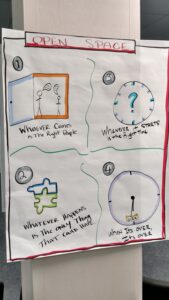 Conflict is a challenging topic for many people to navigate. It’s a natural part of working together in groups, yet in the midst of it, it can feel terribly dysfunctional. There’s no shortage of ideas about how to work through it, and there are lots of tools available. The choice of what tool to use when can feel overwhelming. How do you know where to get started? One of my to-go methods for engaging with conflict is the Waterline Model.
Conflict is a challenging topic for many people to navigate. It’s a natural part of working together in groups, yet in the midst of it, it can feel terribly dysfunctional. There’s no shortage of ideas about how to work through it, and there are lots of tools available. The choice of what tool to use when can feel overwhelming. How do you know where to get started? One of my to-go methods for engaging with conflict is the Waterline Model.
Leadership, People, and Change
Retrospectives Are Real Work, Too
 “We don’t have time for a retrospective. We have ‘real work’ to do.”
“We don’t have time for a retrospective. We have ‘real work’ to do.”
How many times have you heard this? It comes up frequently in the classes I teach, I’ve heard it more times than I care to count. It frustrates me, and yet, I understand where it comes from. This issue isn’t limited to retrospectives. One of the challenges that managers, coaches, and consultants face is helping groups and teams to effectively balance productive work with work that builds and sustains their productivity. The key to that is understanding that working on the group’s functioning is also real work.
How Deep Do You Ask People To Go?
 Some of my most spectacular failures working with teams have come from going deeper than I needed to. One particularly memorable retrospective ended with a product manager declaring, “I’m done talking about my feelings.” (It was not my finest moment.) Yes, organizations are made of people. And yes, work happens inside a container of relationships. But that doesn’t mean every attempt to address a team or organizational problem must be super deep. Choosing the depth at which to intervene is critical for every manager, consultant, and coach.
Some of my most spectacular failures working with teams have come from going deeper than I needed to. One particularly memorable retrospective ended with a product manager declaring, “I’m done talking about my feelings.” (It was not my finest moment.) Yes, organizations are made of people. And yes, work happens inside a container of relationships. But that doesn’t mean every attempt to address a team or organizational problem must be super deep. Choosing the depth at which to intervene is critical for every manager, consultant, and coach.
Should you host an Open Space Session?
 Open Space was inspired by the hallway conversations that occurred at traditional conferences. Open Space needs people who will propose and host sessions. The question is: if you’re attending an Open Space event, should YOU host a session?
Open Space was inspired by the hallway conversations that occurred at traditional conferences. Open Space needs people who will propose and host sessions. The question is: if you’re attending an Open Space event, should YOU host a session?
How to Facilitate a Large Open Space Event

Open Space events can be a great way to organize a large group of people to quickly and effectively address the issues that matter to them. People often leave amazed at how much they learned or accomplished, especially when the event started with an empty agenda. You probably loved an event you attended and now are wondering how to facilitate open space with a large group. Open space can be used within a company or community conference.
Jake and I have both facilitated open space events with 100-1000+ attendees. There is a lot of preparation that goes into making the event go smoothly—in advance of the event and the day-of. There’s more to facilitating open space than walking around a circle and explaining the principles!
Communicating Change Effectively and Humanely

“I can tell this is hard for you all to hear. I know it’s harder for some of you than others. It’s not my first choice, either. However, it makes enough sense, and it’s the direction we’re going now. We’ll take some time to work through how we feel about this. Then we need to figure out how to start making this change.”
Those weren’t exactly the words the Director of Engineering used to communicate the change in our team’s priorities, but they are close. It was certainly the message that those of us in the room heard when he told us about the abrupt shift in the direction we were about to make. This potentially disruptive change was one of my first experiences with communicating change effectively and humanely. Because of how the director held himself and the team during the ensuing conversation, what could have been an absolute mess turned into a surprisingly positive experience.
Share Information, Not Anxiety
 “I don’t want to distract the team. They don’t need to worry about this.” That’s what my boss – the head of engineering at a rapidly growing startup – told me when I asked him how he would share information from top management about our revised expansion plans. His job, he said, was to protect the engineers from things like this and to let them focus on building the product.
“I don’t want to distract the team. They don’t need to worry about this.” That’s what my boss – the head of engineering at a rapidly growing startup – told me when I asked him how he would share information from top management about our revised expansion plans. His job, he said, was to protect the engineers from things like this and to let them focus on building the product.
Working with Group Tensions

Last October, I helped the Agile Alliance Board of Directors with their quarterly meeting. They asked me to write up one of the ways we worked with some difficulties that came up.
Managing Team Performance with the 60-30-10 Rule
You’re a mid-level manager in a rapidly growing company. Your boss tells you that a new initiative the company has been considering for the last year has finally gotten the go-ahead from the executive team. This initiative is similar to others your company has taken on in the previous few years, but it is different in a few key ways. There’s no playbook for work like this; success will require trying new things and learning from what happens. Your job is to pull together a team that will perform at a high level in challenging circumstances. What do you do?
Leadership Isn’t About You

Managers everywhere struggle to lead teams. These teams don’t produce the desired results, leaving everyone frustrated. A common cause of this problem is managers falling into the trap of thinking that leadership is about them. When this happens, a change in perspective can help them regain effectiveness.







